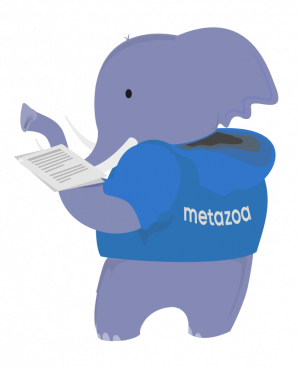Support | Contact Us | Login
Examine the competition carefully before buying tools for org management or technical debt removal.

There are a few companies out there claiming to be experts on how technical debt impacts your Salesforce org. Look closely at their claims. Do they just “detect” technical debt, or can they actually remove the data and metadata responsible for the problem? Do they have tooling for org splits and merges, or do they lack this core competence? Another red flag is when a company can’t really define what they mean by technical debt in the first place. If their description of technical debt sounds vague then they can’t fix the problem. Metazoa has assembled a suite of automated tools that discover and remove technical debt from any Salesforce org. This white paper compares the differences between the tools Metazoa provides and the capabilities available from Elements Cloud and Panaya ForeSight.
Any attempt to analyze technical debt requires detailed and accurate information about metadata dependencies. Metadata assets can refer to other assets by name, and these references form a web of interconnected links. For example, a Permission Set might define access permissions for a Custom Object, or a Dashboard might reference embedded Reports. This information is required to understand the structure of the org and the extent to which assets are being used. The dependencies are also needed to understand how forgotten assets can be deleted with destructive changes.
Discovering all the different metadata dependencies is quite difficult. Over the last 15 years, various product teams at Salesforce invented their own inconsistent methods for handling metadata dependencies and deployments. Metadata references can be found inside metadata assets in many ways, including:
Panaya ForeSight and Elements Cloud support dependency information for about 50 metadata types. This list is available on their websites, the links are provided below. Both companies cover (more or less) the same metadata types. This is almost certainly because they are both using the Salesforce Metadata Component Dependency API. This API covers about 70 different relationships.
There are many problems with the Salesforce Metadata Component Dependency API. This API returns strange results in certain situations. Salesforce announced the API would be deprecated eventually, and there are no plans for a new version. But the biggest issue is that this API covers only a fraction of the available metadata types and the possible relationships between them.
Metazoa has spent over a decade developing our own Dependency API. Our API is the only accurate and complete source of dependency information available on the Salesforce platform. The Metazoa Dependency API covers all 300 metadata types and over 1400 different relationships between them. This implementation uses static analysis on metadata files and is extremely fast. Our API works both on live orgs and developer projects.
Our API covers all the new metadata types for the Verticals, Einstein and Data Cloud. Our solution includes custom parsers for Lightning Web Components, Email Templates, and Visualforce Pages. We also developed an interpreter for Apex Classes and Triggers to identify the language structure.
Metazoa is the industry leader in understanding Salesforce dependencies by an order of magnitude. This core competence is mission critical for technical debt analysis. Here are the reports and applications that use the Metazoa Dependency API:
Metadata Type coverage for Panaya ForeSight, Elements Cloud, and Metazoa Snapshot. This information was found at the vendor website links below:
Imagine a doctor who can diagnose diseases but can’t treat them. Many technical debt reports suffer from this problem. There might be hundreds or thousands of assets that need to be deleted, and the customer must wade through the setup menu to make all the changes. In other cases, like removing inactive users, there can be thousands of required edits that range across multiple metadata types and different junction objects. There is no good way to make manual changes in complex situations like this.
Where appropriate, the Metazoa reports are actionable. After an interactive search for assets that should be removed or modified, the customer can choose to launch sophisticated metadata deployment tooling and make the required changes. Alternatively, they can save the changes in a job list for release management later. Metazoa integrates with Copado, so the customer can also choose to save these changes as a user story.
The Metadata Studio prompt engineering platform makes extensive use of these data migration and metadata deployment capabilities. Customers can transform data and metadata assets and apply those changes across the entire org. The final step in prompt automation creates a developer project for deployment or a dataset for migration. Actionable prompt automation opens up amazing new possibilities for org transformation.
Metazoa duplicates the current snapshot before making any changes. Because of this, the time series history of snapshots will have a backup of the original org. Any mistakes can be rolled back with the deployment tools. For example, if an asset is mistakenly removed there is always a backup copy that can be used for recovery.
Technical debt removal is also important during org splits and merges. Often technical debt will be removed prior to an org split or after an org merge. In this case the cleanup and optimization process can happen along with the other deployments and data migrations.
Neither Panaya ForeSight nor Elements Cloud have any kind of significant metadata deployment or data migration capabilities. This is a serious handicap competing with Metazoa Snapshot which has made a major investment in org management tooling. Here are the Metazoa Snapshot reports that make actionable changes:
Salesforce has spent billions of dollars on secure network infrastructure and security safeguards. They also have impressive security and compliance certifications. Many of the world’s largest companies trust the Salesforce platform. But just because you decided to trust Salesforce does not mean that by extension you should trust their partners. Any partner with an external server hosted outside of Salesforce should be scrutinized with extreme care.
Even if you trust this partner, accidents happen. Who has access to their data center? How do they access that data center? Where is their server hosted? What kind of compliance certifications have the earned? What is their backup and disaster recovery policy? Do they store your data or metadata on their server? Do they store your credentials? How do they segment information from multiple customers? And so on, and so on.
This problem is especially serious where metadata is involved. Because metadata retrieval and deployment require the most sensitive administrative credentials. If these credentials are compromised, then an attacker can access everything in your org, both data and metadata.
Both Panaya ForeSight and Elements Cloud store customer data and metadata on their externally hosted servers. Metazoa Snapshot does not. Our product communicates directly between your personal computer and your Salesforce account. We do not have a database, server, or cloud. We can’t see your data, metadata, or credentials. This is why large government customers and financial institutions trust Snapshot. Our SI partners can use Snapshot for their customers without a third-party security discussion.
Elements Cloud advertises their ability to create Universal Process Notation (UPN) diagrams. These diagrams help document a business process. There are other types of diagrams that people use, including flow charts, Unified Modeling Language, value stream maps, Business Process Management Notation, and SIPOC (supplier, inputs, process, outputs, and customers). There does not seem to be any compelling connection between metadata assets and the resulting diagrams, and at this point Metazoa Snapshot has not introduced any project management diagram or flow chart capabilities.
Elements Cloud also advertises a report dedicated to tracking metadata descriptions. This information is available in various places in Metazoa Snapshot but not in a single report. Metazoa Snapshot provides Metadata Studio to automatically create new descriptions for metadata assets and deploy them in the release management cycle.
Panaya ForeSight provides many services off the Salesforce platform that are beyond the scope of this whitepaper. On Salesforce, many of the unique capabilities they advertise are variations of the Impact Analysis report discussed above, including Release Planning, Root Cause Analysis, and Technical Debt Cleanup. They advertise an Automations Overview report that helps companies migrate to Flows, there is no direct analogue for that report in Metazoa Snapshot.
In the table below the Forgotten Assets row refers to general purpose technical debt identification. None of the line items below reflect the qualitative differences discussed earlier, including the differences in the Dependency API being used and reports that are actionable.
In the table below, the Data Dictionary covers objects and fields, and the Metadata Dictionary covers the other 300 metadata types. Again, there are differences in Impact Analysis based on the underlying API being used.
The Elements Cloud permission matrix report lacks Combined Security reporting and is not actionable for Merging Similar Profiles and Bulk Editing Permissions.
Metazoa Snapshot has the only dedicated tooling for performing Org Splits, Clones, and Merges, this is related to the Metadata Deployment and Data Migration Capabilities. Both Panaya ForeSight and Elements Cloud are doing things with AI but we don’t see a dedicated Prompt Engineering platform advertised by either company.
Metazoa has been working for over a decade on technical debt reduction, org documentation, and org security. These are related concerns, and most of the features we support have come from thousands of helpful suggestions made by our enterprise customers over many years. Check out our battle-tested product line on the AppExchange. If you are a power user, our Snapshot product delivers all these capabilities under one roof with a visual interface.
© 2018-2024 Metazoa. All rights reserved. Proudly made in California
 Congratulations!
Congratulations! 
